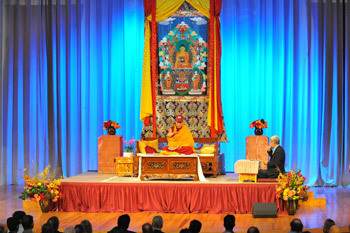Boston, MA, USA, 16 October 2012 - The Prajnopaya Institute of Buddhist Studies invited His Holiness the Dalai Lama to teach Kamalashila’s Middle Stages of Meditation at MIT. He began with the observation that we can develop genuine harmony between our various religious traditions on the basis of mutual respect. Love, compassion and training in single-pointed concentration are among the practices we have in common.
“These days there are people with Judeo-Christian backgrounds who have become interested in Buddhism. That’s fine, but it’s important that maintain a deep respect for their original traditions.”
His Holiness noted that the Buddha spoke about the vehicles of various kinds of practitioner. Clearly, as long as there are varieties of human disposition, there will always be a variety of approaches to spiritual life. Amongst these, Buddhism belongs to the category of non-theistic paths. The Buddhist view is that although there is a conventional self, it is not independent or absolute; it is designated on the basis of the body and mind. Within Buddhism, there is the Pali tradition, followed in Sri Lanka, Thailand and Burma etc, and the Sanskrit tradition followed in China, Korea, Japan and Tibet etc. The Nalanda tradition that was brought from India to Tibet, also flourished in the Mongolian regions. The Pali tradition includes the monastic discipline of the Vinaya fundamental to all Buddhist traditions.
Even before the great monastic university of Nalanda was established, His Holiness explained, there were objections that the Mahayana is not the teaching of the Buddha. However, the great Indian master Nagarjuna defended both the Mahayana and Tantrayana.
“The Heart Sutra contains a dialogue between Shariputra and Avalokiteshvara and was clearly given before an audience who could perceive celestial bodhisattvas. Otherwise, if they could not see and hear Avalokiteshvara, they would only have seen Shariputra talking to himself! I don’t believe the Mahayana is merely a mythical tradition.”
His Holiness made the point that while the first account of the Buddha’s teaching of the Four Noble Truths is found in the Pali tradition, it is only fully explained in the Sanskrit Mahayana tradition. For example, it is difficult to understand what the third truth, true cessation, means without Nagarjuna’s explanation.
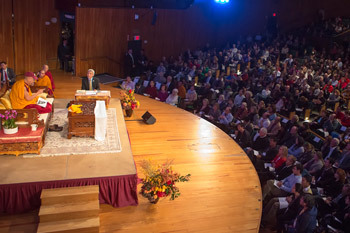 |
| His Holiness the Dalai Lama during his teachings at
MIT's Kresge Auditorium in Boston, MA, on October 16, 2012.
Photo/Christopher Michel |
The Buddha accumulated merit and wisdom for three countless aeons. According to the Pali tradition, until his enlightenment, he was a sentient being, who in the course of meditating through one night became the Buddha. The Sanskrit tradition, however, presents the notion of the four bodies of a Buddha, the emanation, enjoyment, nature and truth bodies. These are hard to understand without the explanations found in the Highest Yoga Tantras. These also explain the dissolution of the elements at the time of death, all of which Nagarjuna describes with wonderful clarity.
In the seventh century, the Indian master Shantarakshita was invited to Tibet. His disciple, Kamalashila followed him there and wrote these Stages of Meditation at the request of the Tibetan emperor. His Holiness said he would not go into detail, but began his reading with the question, what is the mind? He said that this relates to our own experience of happiness. However, we tend to focus on the external conduct that gives rise to the experience, rather than on the experience itself. We experience pain and pleasure on a sensory level, but also on a mental level. It is the mental level that is more effective and it is this mental experience that His Holiness has encouraged scientists to explore. A calm mind can help us overcome physical pain, but sensory pleasure does not put the turbulent mind at ease. His Holiness remarked,
“The Buddha said that no one wants suffering. Sufferings don’t arise because we wish for them; they are beyond our control. But the Buddha made clear that the ultimate cause of suffering is ignorance. We need to overcome that ignorance and we do that on the level of the mind.”
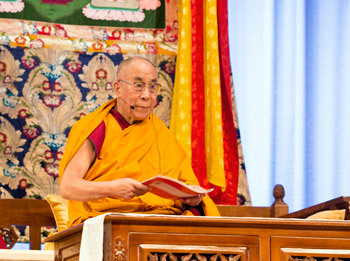
|
His Holiness the Dalai Lama during his teachings in Boston, MA, on October 16, 2012. Photo/Christopher Michel
|
His Holiness clarified that the antidote to ignorance has to be mental and functions in the way that when light comes, darkness disappears, and when light goes, darkness returns. Just as the antidote to anger is loving kindness, the antidote to ignorance is wisdom. As Shantideva states at the beginning of Chapter Nine of Guide to the Bodhisattva’s Way of Life, all the preceding elements of practice were taught by the Buddha to enable us to cultivate wisdom. Ultimately, it is wisdom that will enable us to overcome ignorance. Je Tsongkhapa said that there is nothing dependently originated that is not empty, and there is nothing empty that is not dependently originated and that he took great joy in that instruction.
Quoting Shantideva again, His Holiness clarified that the explanations of emptiness and dependent origination don’t negate everything we see, but rather the way we perceive them that is the root of suffering. Ignorance pervades all our perceptions and in order to overcome it we cultivate an understanding of emptiness and dependent origination. Nagarjuna referred to these teachings as treasure. His Holiness confirmed three aspects of wisdom: the understanding that comes from listening and study; the conviction that comes from deep reflection and the realisation that comes from special insight that also involves a calmly abiding mind. He said,
“Our final destination, Buddhahood, may take us aeons to reach. That doesn’t matter, but it’s better to start now. If we serve others and refrain from harming them we can feel we have led a meaningful life and when death comes, we can go feeling satisfied and confident about our next life.”
Science, Monks and Technology
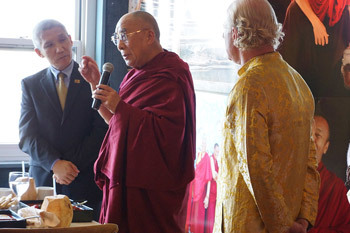
|
|
His Holiness the Dalai Lama speaking to supporters of a new project involving science and monastice studies at a luncheon in Boston, MA, on October 16, 2012. Photo/Jeremy Russell/OHHDL |
His Holiness was invited to lunch with supporters of a new project: Science, Monks and Technology that, in conjunction with the Library of Tibetan Works and Archives seeks to bring together the best of the Tibetan monastic programmes with the best of MIT. His Holiness spoke of his longstanding desire to introduce science to the monasteries that uphold the Nalanda tradition of Buddhist philosophy, science, medicine, arts and crafts and logic. He felt it important to add to these Western knowledge, particularly of science.
Although he was early on advised to be careful about science and spirituality, he decided that Buddhist and modern science involve openness, investigation, experimentation and checking things out for yourself. The dialogues he has engaged in over the last thirty years have focused on cosmology, neurobiology, quantum physics and psychology. Buddhists have learned a great deal, although a casualty has been traditional Buddhist cosmology. Scientists in turn are showing interest in what Buddhism and ancient Indian texts have to say about the mind and emotions, topics that are understood only at a preliminary level in the West. Now experimental programmes are going on. His Holiness thanked this gathering of friends for their valuable support.
Kurukulla Center
At the Kurukulla Center in Medford, one of Boston’s residential neighbourhoods, His Holiness said,
“After we lost our country and became refugees, different opportunities arose. Wherever there are Tibetans outside India, they keep up their Tibetan identity and culture. They take care to study Tibetan and in this they are warmly supported by their local communities. I appreciate the goodwill and support Tibetans receive, thank you.”
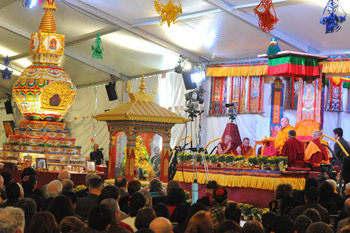
|
His Holiness the Dalai Lama duringhis teaching at the Kurukulla Center in Medford, MA, on October 16, 2012. Photo/Sonam Zoksang
|
He continued that he was happy to visit the centre, saying that although it was sad that Geshe Tsugla was no longer there, his spirit was still very present in what they were doing. He mentioned his own three commitments: encouraging appreciation that human values are a source of happiness; promoting inter-religious harmony and working for the Tibetan cause. With regard to the latter, he clarified that since the election last year of an energetic, Harvard-educated young Tibetan as political leader he had retired. Not only that, but he had also brought the involvement of the Dalai Lamas in Tibetan political affairs to an end. This he regards as a positive democratic development.
“I want us to follow the trend of the twenty-first century for greater openness and democracy. In our small community outside Tibet, we are more advanced than Beijing. Hopefully, sensible leaders in China will follow our practice.”
Addressing Tibetans in their own language he noted that more than fifty years in exile is a long time in an individual’s life, but is not so long in terms of a people’s struggle for freedom. He admired the way Tibetans in exile have preserved their language and culture, informed as it is by Buddhist ideas. Meanwhile, the spirit of Tibetans in Tibet remains strong, all of which gives real grounds for hope.
